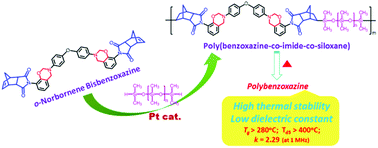Outstanding dielectric and thermal properties of main chain-type poly(benzoxazine-co-imide-co-siloxane)-based cross-linked networks†
Abstract
In this study we used a facile approach to synthesize poly(benzoxazine-co-imide-co-siloxane) (oHPNI-oda-PDMS), a new main chain-type copolymer featuring benzoxazine, imide, and siloxane units as repeating units. In contrast to previously reported polydimethylsiloxane (PDMS)-containing benzoxazine resins, oHPNI-oda-PDMS was formed directly through hydrosilylation of an ortho-norbornene functionalized bisbenzoxazine monomer (oHPNI-oda) and PDMS. Nuclear magnetic resonance and Fourier transform infrared (FTIR) spectroscopy confirmed the chemical structures of oHPNI-oda and oHPNI-oda-PDMS. We used differential scanning calorimetry and in situ FTIR spectroscopy to investigate the polymerization behavior of both the benzoxazine monomer and the copolymer, and used dynamic mechanical analysis, thermogravimetric analysis, and microscale combustion calorimetry to determine the thermal properties and flame retardancy of the cross-linked polybenzoxazines. The polybenzoxazine derived from oHPNI-oda-PDMS possessed an excellent combination of properties—high thermal stability, low flammability, and very low dielectric constants (k = 2.36–2.29)—suggesting many potential applications in aerospace, microelectronics, and flame-resistant materials.



 Please wait while we load your content...
Please wait while we load your content...